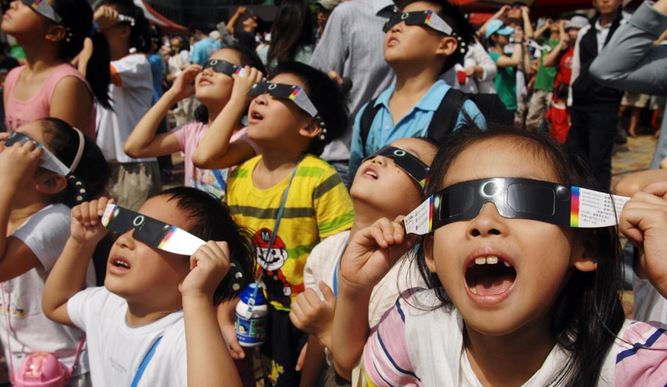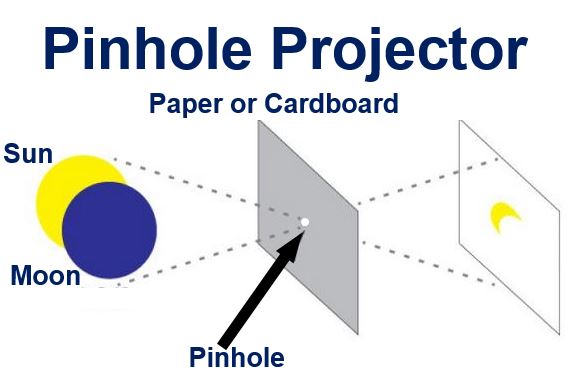Several Scottish primary schools are refusing to let their children go outside during the solar eclipse on Friday morning, March 20th. Professor John Brown, from Glasgow University’s Department of Physics and Astronomy, Scotland’s Astronomer Royal Professor, says this is a big mistake.
Professor Brown says headteachers refusing to allow their children to experience the rare event are depriving them of the “opportunity of a lifetime.”
In today’s litigious society, several schools have decided to keep their kids indoors during the solar eclipse over what they claim are safety fears.

Thousands of Scottish primary school children will be deprived of a rare experience, something the kids in the photograph, and millions of others around the world, have enjoyed over the last ten years.
Professor Brown described their measures and fears as “ridiculous and tragic.”
In an interview with the Herald newspaper, Prof. Brown said:
“This is one of the very few opportunities to see a solar eclipse and it is a great shame if schools cannot do some advance planning, get parents on board and make sure it can be done safely outdoors.”
Executive Director of the Scottish Parents Teacher Council said:
“There is a huge amount of material available to teachers to help them make the most of learning around an eclipse, but managing it safely for a class of primary school children outdoors is a big ask for a teacher.”
Eye health risks during a solar eclipse
On Friday March 20, there will be a partial eclipse in Scotland (not a total solar eclipse). Bear this in mind when reading advice from two expert organizations below:
The US space agency NASA has the following advice for people wishing to experience a solar eclipse:
“The Sun can be viewed safely with the naked eye only during the few brief seconds or minutes of a total solar eclipse. Partial eclipses, annular eclipses, and the partial phases of total eclipses are never safe to watch without taking special precautions.”
“Even when 99% of the Sun’s surface is obscured during the partial phases of a total eclipse, the remaining photospheric crescent is intensely bright and cannot be viewed safely without eye protection.”

During Friday’s solar eclipse, Scotland will have the most darkness (obscuration) in the UK.
The British Astronomical Association says:
“Don’t view the Sun through sunglasses of any type (single or multiple pairs), or filters made of black & white or colour photographic film, or any combination of photographic filters, crossed polarisers or gelatin filters, CDs, CD-ROMs, or smoked glass. These are not safe.”
“Do view the Sun only through special filters made for safe solar viewing, e.g. aluminised mylar filters, or black polymer filters, identified as suitable for direct viewing of the Sun, bearing the CE mark and a statement that it conforms to European Community Directive 89/686/EEC, or use a welder’s glass rated at No. 14 or higher. Always read and follow the manufacturer’s instructions carefully.”

A solar eclipse can be experienced safely with a pinhole projector (pinhole camera), as long as you don’t look up directly at it with the naked eye.
Children devastated
Children in New Machar, Aberdeenshire, at the local primary school, were devastated when told plans to watch the rare cosmic event had been shelved because of safety fears, according to several Scottish media sources.
Paul Rooke, headteacher of New Machar Primary School wrote a letter to parents last week, saying:
“It is with disappointment that I need to advise you that we will no longer be purchasing the solar eclipse glasses and viewing the eclipse as a school. This is after further careful consideration of the health and safety advice, alongside guidance from Aberdeenshire Council’s Health and Safety colleagues.”
“Clearly the school will never take any risks around pupil safety and wellbeing. I do hope you understand my decision.”
According to Mr. Rooke, a report in the Internet indicated that special eclipse glasses may be too big for primary school children, and consequently not safe.
Parents of the schoolchildren said they were disappointed. The Mail quoted Euan Pittendreigh, a parent, who said “It just seems like a little bit too much political correctness. I understand that it’s for the kids’ safety, but if the glasses fit my kids correctly I’d let them see it.”
Another parent, Derek Mathers said “It’s a shame. My daughter Kirsty was looking forward to seeing the eclipse, but the school has got to put safety first really.”
Director of Education and Children’s Services at Aberdeenshire Council, Maria Walker said “Schools will decide individually on activities to watch the eclipse and will do so safely.”
Early scientists and eclipse-related eyesight problems
Thomas Harriot (1560-1621), an English astronomer and mathematician, wrote in 1612 that after viewing the Sun his “sight was dim for an hour.”
English astronomer and mathematician John Greaves (1602-1652) once said that following Sun observations he saw afterimages that resembled a flock of crows in his vision.
Isaac Newton blinded himself for three days after trying to look at the Sun in a mirror. He went on to experience afterimages for months.
There are no comprehensive statistics regarding the prevalence of eye damage after a solar eclipse. A clinic in Leicester, UK, reported 45 patients showing up following the 1999 solar eclipse. Forty of them were confirmed to have some sort of damage or symptoms, with five having visible changes to their retina.
Twenty of the Leicester clinic patients complained of eye pain, while another 20 reported vision problems. Twelve of them experienced a total recovery within seven months, while four continued seeing ‘ghosts’ of the damage in their visual field.
Live Science quoted a 2001 study published in The Lancet which reported there had been more cases of eye damage before media warnings not to look at the eclipsing sun with the naked eye became widespread.

